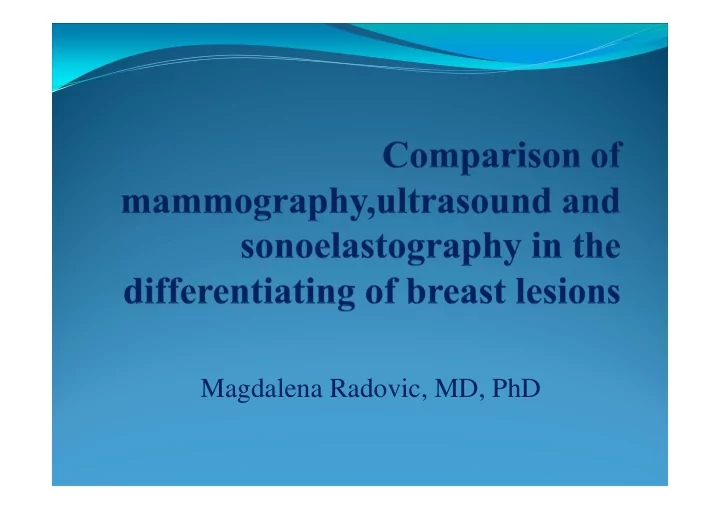

Magdalena Radovic, MD, PhD
Benign Malignant -The most frequent female -Incidence clinical 50%, malignancy-25% of all malignancies histological 90% -The frequent cause of death in female population-15% -Increasing from 20 yrs, peak in 40 and 50 yrs -Increasing incidence from 35yrs of life - Nonproliferative lesions -Incidence: 68/100.000 (no risk) -Mortality: 20/100.000 - Proliferative lesions without -Serbia in Europe- 2. place atypical hyperplasia (1.5-2 times) (mortality) and 18. place (incidence) in brest cancer statistics - Atypical hyperplasia(3.5-5 times)
Objective � The purpose of this study was to evaluate the value of ultrasound elastography (UE) in differentiating benign versus malignant lesions in the breast and � compare it with conventional sonography � and mammography
Literature data* Clinical breast Ultrasound Mammography MR exam examination 60-85% 68-98% 68-85% 90% sensitivity 60-70% 73% 90% 75% specificity 75% 52% 70% 44%-66% PPV 86% 88.3% 98-100% NPV *Zhi H. J Ultrasound Med.2007.
Method A total of 128 breast lesions (73 malignant and 55 benign) in 125 women (mean age 54 years, range 21-84 yrs) were enrolled in this one year prospective study that was conducted in Clinical Center “Bezanijska kosa” in Belgrade. Clinical Breast Examination (CBE) 1. Questionnaire 2. X SD Mammography 3. Ultrasound 4. Age 54.79 14.71 Sonoelastography 5. 6. Pathohistological result
Definitive pathohistology Nonproliferative lesions Proliferative lesions without atypia Proliferative lesions with atypia Malignant lesions
p= 0.002 p= 0.009 � Benign lesions at premenopausal patients-52.7% � Malignant lesions in postmenopuausal patients-67.1% p= 0.03
RESULTS Mammography as diagnostic tool Sensitivity 97.3% 41.9 % Specificity 2.7 % False-negative rate 50.9 % False-positive rate 71.7 % PPV 93.1 % NPV 76.7 % Accuracy
RESULTS Ultrasonography as diagnostic tool Sensitivity 100 % 21.8 % Specificity 0 % False-negative rate 78.2 % False-positive rate 62.9 % PPV 100 % NPV 66.4 % Accuracy
RESULTS Results for TES Sensitivity 95 % 61.8 % Specificity 5 % False-negative rate 28.2 % False-postive rate 76.9 % PPV 91.9 % NPV 81.3 % Accuracy Results for SR Sensitivity 97.3 % 55.6 % Specificity 2.7 % False-negative rate 44.7 % False-postive rate 74.7 % PPV 93.8 % NPV 78.9 % Accuracy
RESULTS Comparison of Sensitivity, Specificity, Accuracy,false-negative, false- positive rate, PPV, NPV and accuracy for diagnostic tools Sensitivity Specificity False-negative False-positive PPV NPV Accuracy CBE 75% 33% 25% 67% 59% 50% 57% Ultrasound 100% 21.8% 0% 78.2% 62.9% 100% 66.4% TES 95% 61.8% 5% 28.2% 76.9% 91.9% 81.3% SR 63% 81.5% 34.3% 18.5% 82.8% 63.8% 56.2% Mammography 97.3% 41.9% 2.7% 50.9% 71.7% 93.1% 76.7%
ROC curve for TES and SR AUC p CI 95% 0.866 TES < 0.001 0.797-0.934 SR 0.820 0.742-0.898 0.874 TES and SR 0.807-0.941
ROC curve for ultrasound and TES AUC p CI 95% 0.866 TES < 0.001 0.797-0.934 US 0.905 0.853-0.958 0.949 TES and US 0.912-0.987
ROC curve for mammography, ultrasound and i elastography (TES) AUC p CI 95% 0.866 TES < 0.001 0.797-0.934 US 0.905 0.853-0.958 Mammography 0.784-0.914 0.849 Mammography, 0.924-0.990 0.957 US and TES
TES 3 SR 1.98 Benign-FCC
TES 3 SR 5.11 Ca mucinosum
TES 5 SR 8.53 Ca mucinosum
TES 5-IDC
IDC, triple neg . TES 5
Take away message � The best results in differentiation of benign versus malignant lesions have combination of all diagnostic modalities.
Recommend
More recommend